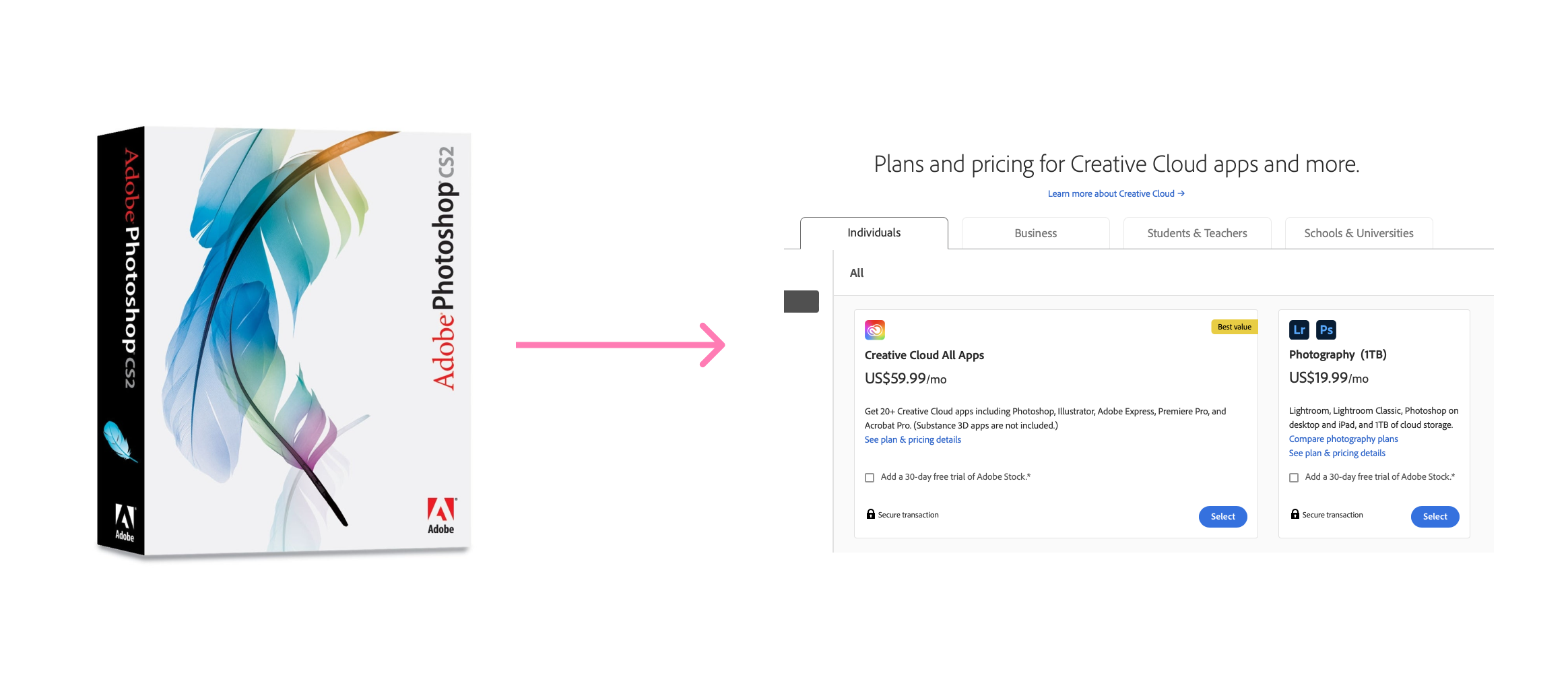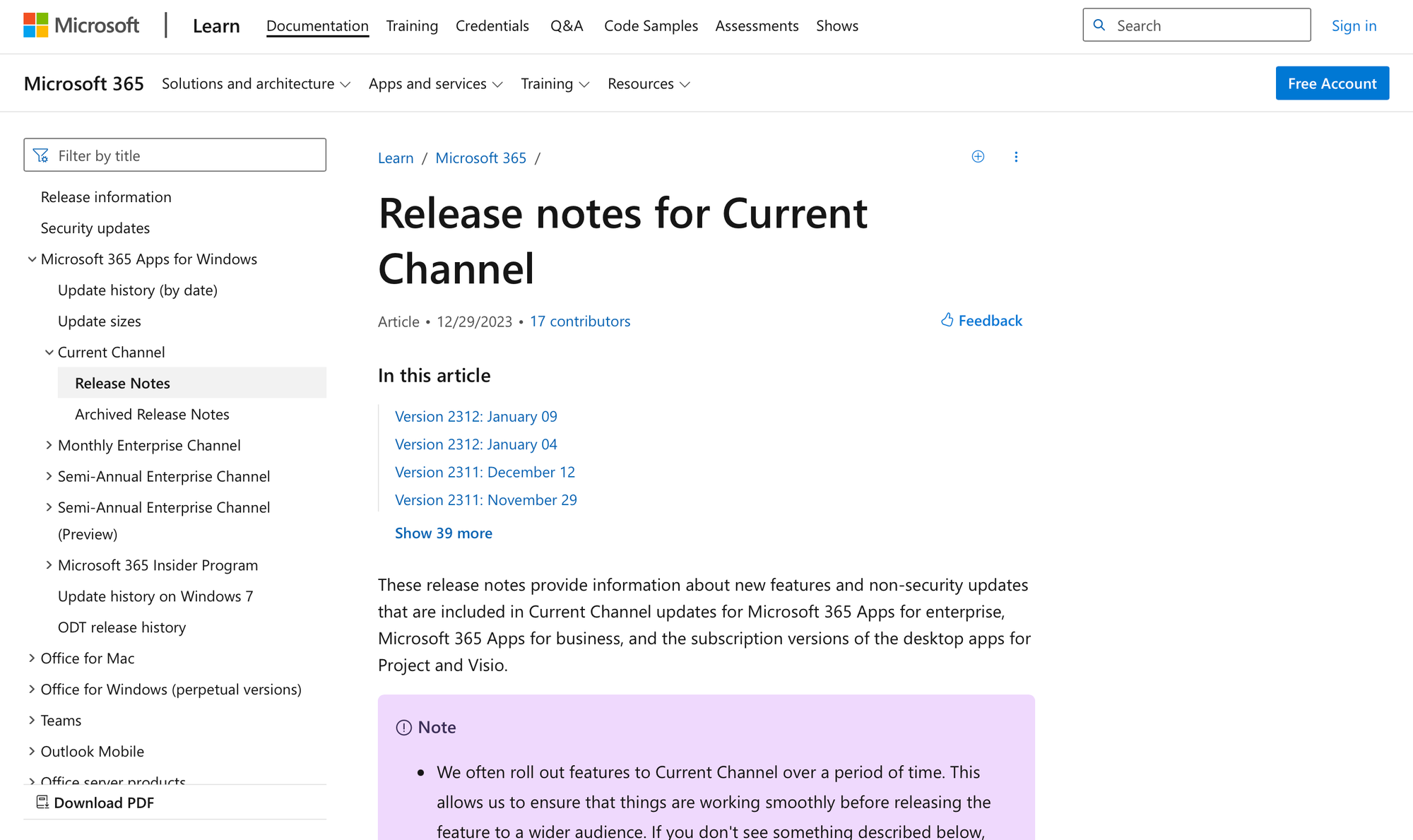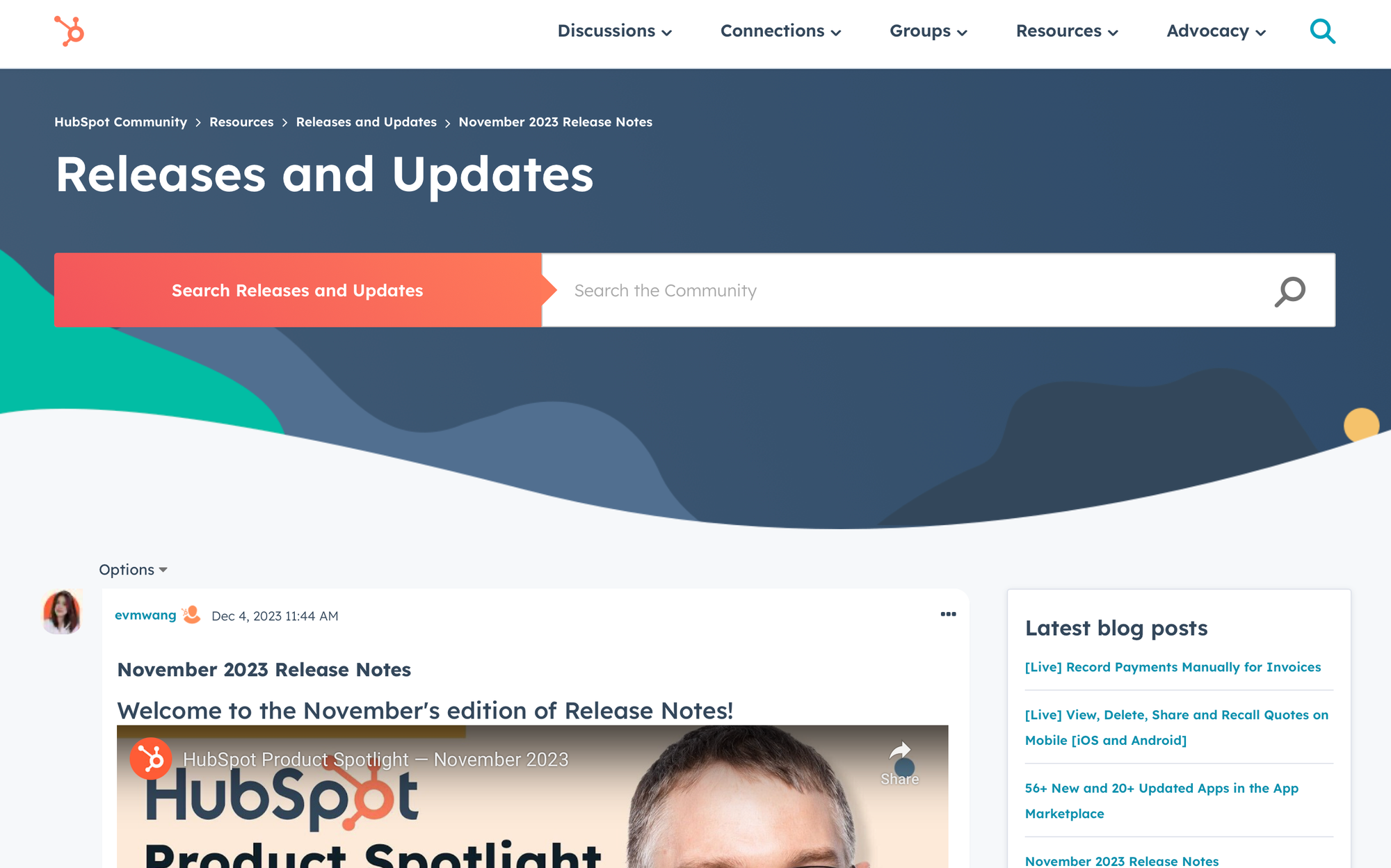
In today's fast-paced business world, keeping up with the competition and making customers happy is important. One way to do this is by continuously improving and developing new ideas.
Particularly for Subscription-as-a-Service (SaaS) businesses, product updates help customers know your product ain't dead. While you don't promise product updates will be rolled out when you show your pricing plan, it's expected at this point.
Unlike a boxed product, which is very rare nowadays (remember those days? 🥲), subscription models can push updates since they're being paid weekly, monthly, or yearly.

Product updates play a big role—they help improve features, fix problems, and add new things. It's essential to tell customers about these updates in a way that builds trust and keeps them satisfied.
Your phone, car, or co-working space is now a subscription model. It keeps the money coming in and funds continuous development.

So, if you're a SaaS business, you're probably updating your product. The question is: Should you use a Knowledge Base to share these product updates?
In this article, we'll discuss the pros and cons of using a Knowledge Base to share product updates with customers.
The Benefits of Using a Knowledge Base for Product Updates
In the ever-evolving digital landscape, efficient communication of product updates is paramount to user satisfaction, retention, and expansion.
If an update is pushed but nobody hears about it—did it really happen? 🤔
A Knowledge Base can emerge as a strategic ally in this endeavor, offering a centralized solution to disseminate information about product updates.
It can provide a streamlined and efficient way for businesses to communicate changes and improvements to their software offerings.
In this section, we'll explore the significant benefits of leveraging a Knowledge Base for communicating timely and relevant product updates.
Time Efficiency
One of the primary advantages of utilizing a Knowledge Base for product updates is the time it saves for both customers and support teams.
You probably already pay or have built a Knowledge Base for customers to help themselves. Why not make the most of it?

Our content in monthly bitesized emails
Get our best content delivered straight to your inbox.
SubscribeWhether you update individual articles or create new ones just for the updates, it can make the whole process easier.
Centralized Location for Updates
By maintaining a centralized repository for product updates, businesses can streamline communication for both customers and internal teams.
Customers no longer need to navigate through various channels to find the latest information, they can simply refer to your Knowledge Base. This not only reduces confusion but also ensures consistency in the messaging.

This means that all documentation is created and published inside one content management system (CMS) reducing the burden on support teams and the team that trains them.
Reduction in Support Tickets
A well-maintained Knowledge Base can significantly decrease the volume of support tickets related to routine inquiries about product updates.
Users can independently access information, troubleshoot issues, and implement new features, reducing the burden on customer support teams and allowing them to focus on more complex queries.
By updating articles regularly with notes about previous versions or new flows, it's easier to manage the whole proccess.
Consistent and Coherent Messaging
By using your Knowledge Base for your product updates, you're ensuring consistency in the messaging surrounding product updates. Especially when paired with a style guide for all your self-help documentation.

When information is centralized and well-organized, businesses can present a unified and coherent message to their user base.
This consistency is crucial for avoiding confusion and misinterpretation of updates. Whether users access the Knowledge Base through the website, customer portal, or within the product interface, they receive the same accurate and up-to-date information, fostering trust and reliability.
Drawbacks of Using a Knowledge Base
While a Knowledge Base stands as a valuable tool for effective communication, it is important to recognize that its implementation is not without challenges.
In this section, we will delve into the drawbacks associated with using a knowledge base for product updates.
By understanding these potential limitations, SaaS companies can make informed decisions about whether a Knowledge Base aligns with their unique product update needs and consider strategies to mitigate any associated challenges.
Mixed Content Types
Implementing a Knowledge Base can be time-consuming, particularly in the initial stages. Some businesses may be better off with an FAQ page instead to start with.
Creating and organizing content, ensuring accuracy, and setting up an intuitive structure require careful planning and execution. Businesses need to invest time and resources to establish a robust Knowledge Base infrastructure.

It can be tricky to set apart your usual help content from your product updates. Search can get confusing and mixed up, links can get lost for older updates, and articles need to be reguarly updated.
Suitability for All Products and Customers
While a Knowledge Base is a valuable tool for many businesses, it may not be suitable for all types of products or customers.

Some user bases may prefer traditional communication channels, and certain products may require more personalized support. Understanding the preferences and needs of your audience is essential in determining if a Knowledge Base is the right solution.
Limited Interactivity and Personalization
One drawback of Knowledge Bases is their inherent limitation in fostering interactive or personalized user experiences.
While they provide valuable information, they may lack the dynamic engagement found in other communication channels.
Unless specifically implemented, a Knowledge Base won't specifically know what version of software a user is currently on.

Some users may prefer more interactive methods of receiving updates, and a Knowledge Base might not cater to those who seek a personalized touch in their communication.
Potential Overwhelm for Non-Technical Users
Knowledge Bases are often designed with a certain level of technicality, assuming a baseline understanding of the product or service.
This can be overwhelming for non-technical users who may find the information too detailed or complex. Ensuring that the content is accessible to a diverse audience with varying levels of technical expertise becomes a challenge, potentially leaving some users feeling excluded or confused.

If your user has to choose from a long dropdown of version types, it may be unclear to them which to choose. In other words—things can get real confusing real quick.
Maintenance Burden for Comprehensive Content
Maintaining a comprehensive Knowledge Base requires ongoing effort and resources. The process involves regularly updating content to reflect the latest product changes, addressing user feedback, and ensuring accuracy.

The maintenance burden can become significant, especially for businesses with frequent updates, multiple products, or a large user base. Devoting resources to consistently curate and update content can be time-consuming and may divert attention from other critical tasks.
Factors to Consider When Deciding on Product Updates
Determining the frequency and nature of product updates is a nuanced decision that depends on various elements unique to your company.
From the size of the customer base to the technical expertise required, understanding these factors is crucial for crafting an update strategy that aligns with both business objectives and user expectations 🪴
This section will explore the key considerations that SaaS companies should weigh when deciding on product updates.
Size of Customer Base
The size of your customer base plays a crucial role in deciding whether to implement regular product updates through a Knowledge Base.
For larger customer bases, the self-service aspect becomes more critical, as handling individual inquiries can be overwhelming. Smaller customer bases may benefit from more personalized communication methods.
Tools like Canny or AnnounceKit work better for agile teams that can move fast and ship updates to their customers with relative ease.

Enterprise companies with thousands or millions of customers will likely find this harder, though it's not impossible.
Frequency and Cycle of Updates
Businesses with frequent updates across a broad range of products may find a Knowledge Base more useful, as it allows for more categorization and modular access without overwhelming traditional communication channels.
For companies with fewer updates or products, the overhead of maintaining a comprehensive Knowledge Base may outweigh the benefits.

We release our product updates monthly and since we only have one product to support, we share our updates through our blog rather than on our Knowledge Base.
Customer Feedback
Gauging customer feedback is a critical factor in deciding on how to share your product updates.
Actively seeking and analyzing customer opinions and suggestions provides valuable insights into their preferences and pain points. Customer feedback not only helps in identifying areas for improvement but also ensures that updates align with user expectations, enhancing overall satisfaction.
This can be done through your Knowledge Base but it's probably more sensible to do this through other channels so it doesn't get mixed in with your other help content.
Industry Trends
Staying attuned to industry trends is useful when determining the direction and timing of product updates.
A keen awareness of what competitors are doing and an understanding of emerging technologies or market demands can influence the decision-making process. Adapting to industry trends ensures that product updates are not only relevant but also position the business as a forward-thinking player in the market.
Best Practices for Creating and Maintaining a Product Updates Knowledge Base
A well-crafted Knowledge Base stands as a cornerstone for businesses aiming to keep their customers informed and satisfied.
Let's explore essential best practices tailored specifically for creating and maintaining a knowledge base focused on product updates.
Keep Content Up-to-Date
Regularly update the content within your Knowledge Base to ensure accuracy and relevancy. Outdated information can lead to confusion and frustration among users.
Implement a content review schedule and encourage user feedback to identify areas that may need updating.
Make updating your help content part of the product release process. This can be done through championing your Knowledge Base inside product meetings and getting help or extra context from topic experts.
Make It Easily Searchable
A user-friendly search function is essential for a successful Knowledge Base.

Implement clear and intuitive search features for product updates by categorizing information logically, and utilize tags and keywords effectively.
You could add tags for each product release version (e.g. 1.2.1) so that people can dive down and filter inside your search.
By making sure you consider the search function, you ensure that users can quickly locate the information they need.
Provide Clear Instructions for Customers
When communicating product updates, clarity is key.
Use plain language (unless it requires expertise) and provide step-by-step instructions to guide users through changes or new features. Visual aids, such as screenshots or videos, can enhance comprehension and improve the overall user experience.
Employ Version Control to Track Changes
Implement version control mechanisms to track and document changes within the Knowledge Base.
This ensures transparency in the update history, allowing writers to trace the evolution of the product over time. This will allow technical writers to understand previous versions of your product or feature and compare the differences, so they can highlight them to your users.
Consider Your Customer Base and Product
The decision to use a product updates Knowledge Base is contingent on your company's specific needs, customer base, and update frequency.
You should have a thorough understanding of the unique dynamics of your business, its products, and the expectations of its user base.
For some, using a Knowledge Base makes sense. This is particularly true for enterprise companies who have multiple products, many releases, and need some way for users to navigate all of your information in the same place.
If you're a smaller SaaS company it probably doesn't make sense.
If you can focus your updates into cycles and have a way to communicate the updates through a channel that's not too complicated, a Knowledge Base probably doesn't make sense for you for your product updates.
A Knowledge Base has the potential to simplify the way product updates are communicated, fostering a culture of transparency, collaboration, and user-centric innovation. But make sure it's right for you and your company.

